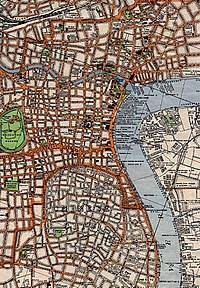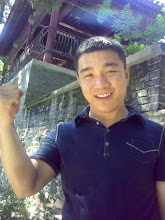


A view of The Bund in Shanghai
The bund and its many wharves are shown in this 1933 map.
The Bund (simplified Chinese: 外滩; traditional Chinese: 外灘; pinyin: Wàitān) is an area of Huangpu District in Shanghai, People's Republic of China. The area centres on a section of Zhongshan Road (East-1 Zhongshan Road) within the former Shanghai International Settlement, which runs along the western bank of the Huangpu River, facing Pudong, in the eastern part of Huangpu District. The Bund usually refers to the buildings and wharves on this section of the road, as well as some adjacent areas. The Bund is one of the most famous tourist destinations in Shanghai. Building heights are restricted in this area.

Name
See also: Bunding
The word "Bund" means an embankment or an embanked quay, and comes from the Urdu word band, meaning an embankment, levee or dam (a cognate of English terms, bind and band, German term, bund, etc.). "Bund" is pronounced to rhyme with "fund". The term was brought to India (where it came to be pronounced as "bund") by either the Mughals in at the beginning of the 16th century, or possibly, by the Baghdadi Jews like the family of David Sassoon, and thence to Shanghai by the family of Victor Sassoon. There are many "bands" to be found in Baghdad, even today. There are numerous sites in India, China, and Japan which are called "bunds". However, "The Bund" as a proper noun almost invariably refers to this stretch of embanked riverfront in Shanghai
History
The Shanghai Bund has dozens of historical buildings, lining the Huangpu River, that once housed numerous banks and trading houses from Britain, France, the U.S., Russia, Germany, Japan, The Netherlands and Belgium, as well as the consulates of Russia and Britain, a newspaper, the Shanghai Club and the Masonic Club. The Bund lies north of the old, walled city of Shanghai. This was initially a British settlement; later the British and American settlements were combined in the International Settlement. A building boom at the end of 19th century and beginning of 20th century led to the Bund becoming a major financial hub of East Asia. The former French Bund, east of the walled city was formerly more a working harbourside.
By the 1940s the Bund housed the headquarters of many, if not most, of the major financial institutions operating in China, including the "big four" national banks in the Republic of China era. However, with the Communist victory in the Chinese civil war, many of the financial institutions were moved out gradually in the 1950s, and the hotels and clubs closed or converted to other uses. The statues of colonial figures and foreign worthies which had dotted the riverside were also removed.
In the late 1970s and early 1980s, with the thawing of economic policy in the People's Republic of China, buildings on the Bund were gradually returned to their former uses. Government institutions were moved out in favour of financial institutions, while hotels resumed trading as such. Also during this period, a series of floods caused by typhoons motivated the municipal government to construct a tall levee along the riverfront, with the result that the embankment now stands some 10 metres higher than street level. This has dramatically changed the streetscape of the Bund. In the 1990s, Zhongshan Road (named after Sun Yat-sen), the road on which the Bund is centred, was widened to ten lanes. As a result, most of the parkland which had existed along the road disappeared. Also in this period, the ferry wharves connecting the Bund and Pudong, which had served the area's original purpose, were removed. A number of pleasure cruises still operate from some nearby wharves.
In the 1990s the Shanghai government attempted to promote an extended concept of the Bund to boost tourism and land value in nearby values, as well as to reconcile the promotion of "colonial relics" with the Socialist ideology. In its expanded form, the term "Bund" (as "New Bund" or "Northern Bund") was used to refer to areas south of the Yan'an Road, and a stretch of riverfront north of the Suzhou River (Zhabei). Such use of the term, however, remains rare outside of the tourism literature.
From 2008, a major reconfiguration of traffic flow along the Bund will be carried out. The first stage of the plan involved the southern end of the Bund, and saw the demolition of a section of the Yan'an Road (formerly Edward VII Avenue) elevated expressway, which will remove the large elevated expressway exit structure which formerly dominated the confluence of Yan'an Road and the Bund. The second stage, begun on 1 March 2008, involves the removal and complete restoration of the century-old Waibaidu Bridge (formerly Garden Bridge) at the northern end of the Bund. The restoration is expected to be completed by early 2009. The next and largest stage of the plan involves a reconstruction of the Bund roadway. The current 8-lane roadway will be rebuilt as in two levels, with four lanes on each level. This will allow part of the Bund road space to be restored to its former use as parkland and marginal lawns. The new concrete bridge built in 1991 to relieve traffic on Waibaidu Bridge will also be rendered obsolete by the new double-levelled roadway, and will be demolished.


Layout
The Bund stretches one mile along the bank of the Huangpu River. Traditionally, the Bund begins at Yan'an Road (formerly Edward VII Avenue) in the south and ends at Waibaidu Bridge (formerly Garden Bridge) in the north, which crosses Suzhou Creek.
The Bund centres on a stretch of the Zhongshan Road, named after Sun Yat-sen. Zhongshan Road is a largely circular road which formed the traditional conceptual boundary of Shanghai city "proper". To the west of this stretch of the road stands some 52 buildings of various Western classical and modern styles which is the main feature of the Bund (see Architecture and buildings below). To the east of the road was formerly a stretch of parkland culminating at Huangpu Park. (This park is the site of the infamous sign reported to have proclaimed "no dogs or Chinese", although this exact wording never existed. Further information, including an image of the sign, can be found at the article on Huangpu Park.) This area is now much reduced due to the expansion of Zhongshan Road. Further east is a tall levee, constructed in the 1990s to ward off flood waters. The construction of this high wall has dramatically changed the appearance of the Bund.
Near the Nanjing Road intersection stands what is currently the only bronze statue along the Bund. It is a statue of Chen Yi, the first Communist mayor of Shanghai. At the northern end of The Bund, along the riverfront, is Huangpu Park, in which is situated the Monument to the People's Heroes - a tall, abstract concrete tower which is a memorial for the those who died during the revolutionary struggle of Shanghai dating back to the Opium Wars.
Architecture and buildings
The Bund houses 52 buildings of various architectural styles such as Romanesque, Gothic, Renaissance, Baroque, Neo-Classical, Beaux-Arts, and Art Deco (Shanghai has one of the richest collections of Art Deco architectures in the world). From the south, the main buildings are:
Asia Building (No. 1, The Bund), originally the McBain Building, housed the Shanghai offices of Royal Dutch Shell and Asiatic Petroleum Company.
Shanghai Club (No. 2, The Bund), which was the principal social club for British nationals in Shanghai.
Union Building (No. 3, The Bund), housed a number of insurance companies.
The Mercantile Bank of India, London, and China building (No. 4, The Bund), housed the Mercantile Bank of India, London and China, built between 1916-1918.
Nissin Building (No. 5, The Bund), housed a Japanese shipping company.
China Merchants Bank Building (No. 6, The Bund), housed the first Chinese-owned bank in China.
The Great Northern Telegraph Corporation Building (No. 7, The Bund), housed the The Great Northern Telegraph Company. Site of the first telephone switch in Shanghai in 1882.
Russel & Co. Building (No. 9, The Bund), now houses the China Shipping Merchant Company.
The HSBC Building (No. 12, The Bund), now used by the Shanghai Pudong Development Bank, was once the Shanghai headquarters of the Hongkong and Shanghai Banking Corporation, which failed to reach a deal with the Shanghai government to buy the building again in the 1990s, when the Shanghai government moved out of the building that they had used since the 1950s. The present building was completed in 1923. At the time, it was called "the most luxurious building between the Suez Canal and the Bering Strait". Its famous ceiling mosaics have been fully restored, and can be viewed inside the entrance hall.
The Customs House (No. 13, The Bund), was built in 1927 on the site of an earlier, traditional Chinese-style customs house. The clock and bell was built in England and in imitation of Big Ben.
China Bank of Communications Building (No. 14, The Bund), was the last building to be built on the Bund. It now houses the Shanghai Council of Trade Unions.
Russo-Chinese Bank Building (No. 15, The Bund) is now the Shanghai Foreign Exchange.
Bank of Taiwan Building (No. 16, The Bund) is now the China Merchants Bank.
North China Daily News Building (No. 17, The Bund) housed the most influential English-language newspaper in Shanghai at the time. Today it houses AIA Insurance.
Chartered Bank Building (No. 18, The Bund) housed the Shanghai headquarters of the Standard Chartered Bank.
Palace Hotel (No. 19, The Bund), today forms part of the Peace Hotel.
Sassoon House (No. 20, The Bund), with the attached Cathay Hotel, was built by Sir Victor Sassoon. It was, and still is today, famous for its jazz band in its cafe. The top floor originally housed Sassoon's private apartment. Today, it forms the other part of the Peace Hotel.
Bank of China Building (No. 23, The Bund) housed the headquarters of the Bank of China. The stunted appearance of the building is attributed to Sassoon's insistence that no other building on the Bund could rise higher than his.
Yokohama Specie Bank Building (No. 24, The Bund) housed the Japanese Yokohama Specie Bank.
'Yangtsze Insurance Association Building (No. 26, The Bund) Today houses the a Shanghai branch of the Agricultural Bank of China.
Jardine Matheson Building (No. 27, The Bund) housed the then-powerful Jardine Matheson company.
Glen Line Building (No. 2 Beijing Road) today houses the Shanghai Broadcasting Board.
Banque de l'Indochine Building (No. 29, The Bund) housed the French bank, Banque de l'Indochine.
Consulate-General of the United Kingdom (No. 33, The Bund) housed the Consulate-General of the United Kingdom. The building is under renovation to be opened as the Peninsula Hotel, Shanghai. 

没有评论:
发表评论